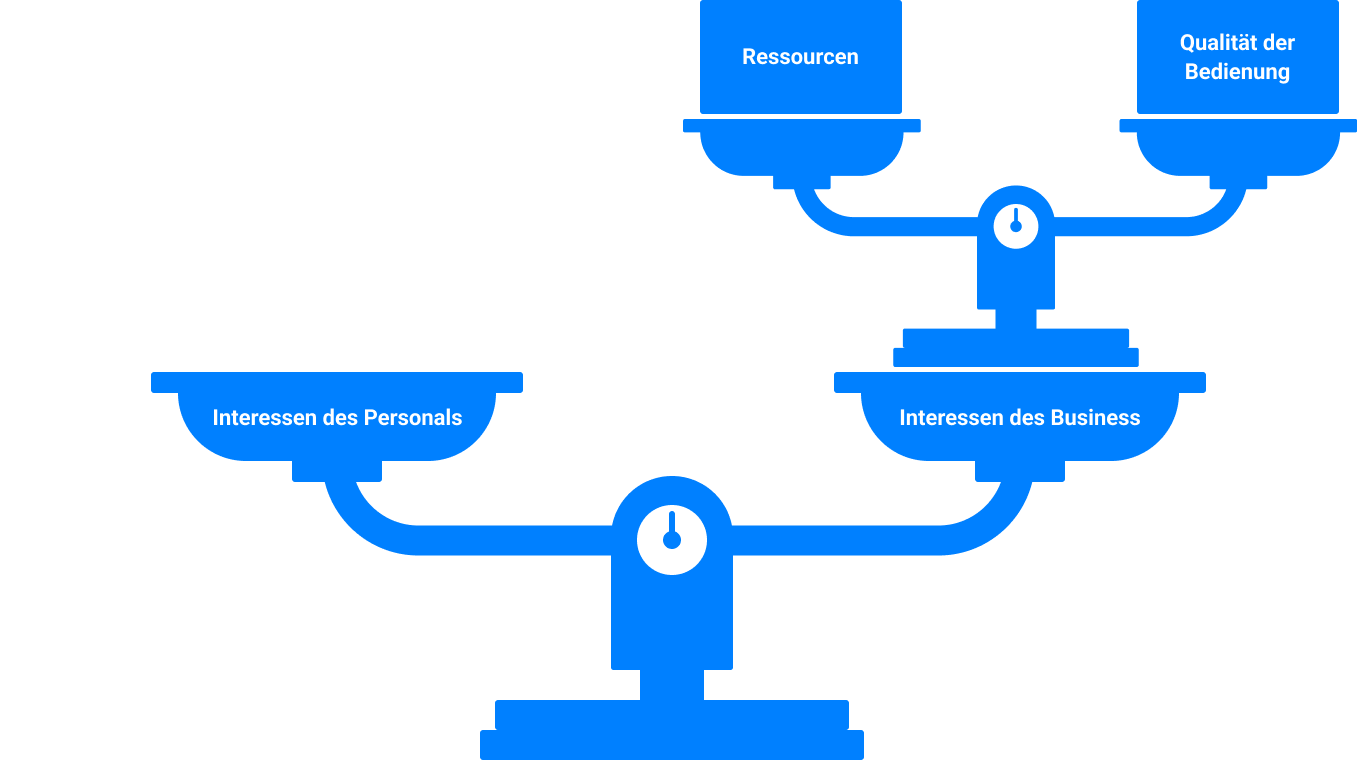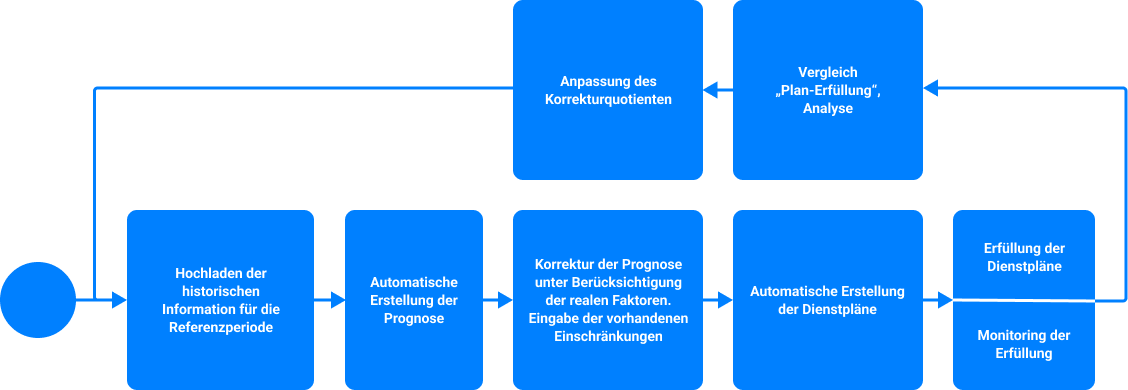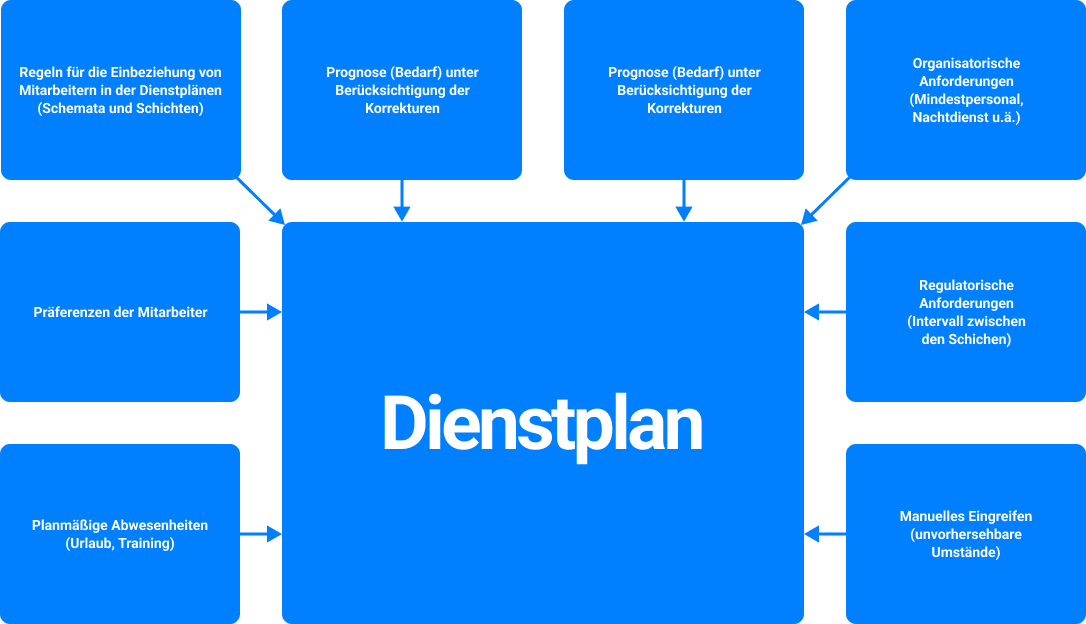What is WFM?
WFM (Workforce Management System) forecasts staffing needs in retail, banking, contact centers and other industries. WFM creates flexible staffing plans based on historical data, taking into account individual preferences and skills.
Why is WFM important?
WFM unifies all workforce scheduling requirements by taking into account employee and employer needs, as well as employee skills and labor law constraints. WFM improves overall scheduling quality through automation; this is especially important for large work teams.
What is the main task of WFM?
WFM takes care of workload forecasting, shift and vacation planning, training and rapid replacement of employees in case of illness and other unforeseen situations. WFM also monitors the situation in real time, collects statistics and generates reports.
Who benefits from WFM - the business or the staff?
WFM systems support companies in the work planning of their personnel. Duty rosters can be created quickly and automatically without any problems. Especially for companies with a high number of employees and shift work, a software is helpful, which can reliably create flexible duty rosters, automated.
The industries where WFM is most widely used are contact centers, various customer services, retail and many more. My colleagues and I are engaged in automating the work of contact centers. WFM systems are of particular importance for our projects.
In our working practice, we often encounter one-sided and simplified ideas about these systems. For example, we may hear statements such as "Contact centers with less than 50 agents do not need WFM systems" or "Excel is enough for experienced managers to create rosters for up to 400 agents" or else "System XY is a good WFM system.
Before the implementation of the system, we used to create the rosters by hand in 8 hrs; the WFM reduced the time to 1 hr" etc.
This means that the business often evaluates the efficiency of such systems primarily on the basis of the possible or achieved savings in the working time of the manager dealing with the duty rosters.
As one can clearly see from the statements, the efficiency of WFM systems is often measured only in terms of the achieved saving of working time from the creation of duty rosters. However, the functional possibilities are much more diverse and extensive. Workforce management systems serve as a support for companies that, despite increasing cost pressure, want to meet the requirements of customers as well as the wishes of agents in the creation of duty rosters. These goals are in no way contradictory to increasing productivity and saving expenses.
What are the benefits of using WFM systems to their fullest extent?
Workforce management systems serve as support for companies that, despite increasing cost pressure, want to meet the requirements of customers as well as the wishes of agents in the creation of duty rosters. These goals are in no way contradictory to increasing productivity and saving expenses.
- The analysis and calculation of staff requirements help you to achieve your set service level and to satisfy all customers as well as employees
- The motivation and productivity of your employees is increased when their working time requests are taken into account, means more customer satisfaction, thanks to satisfied agents
- The resulting increase in employee motivation helps you to retain your staff and prevent the constant turnover of personnel due to layoffs, saving recruiting costs and training times.
- Your agents have different skills, plan them with an optimized WFM system and your customers will get directly to the right contact person.

But let's proceed in order. Let's start with the process of creating the duty rosters. The duty roster represents the distribution of labor resources in time. The life cycle of labor resources control and rosters are schematically shown in Fig. 2.

The creation and fulfillment of the duty rosters is always an interaction process, where necessary statistical data must be collected for the more accurate setting of the system at each step. In this process, one is supported by the WFM system at all times. The system module responsible for creating the duty roster must be able to take into account a large number of parameters, requirements, conditions and constraints. On the one hand, these are determined by the forecasted workload, on the other hand, they take into account the specifications of the regulator. But they are also determined by the conditions and preferences of the agents, as well as by certain conditions and regulations of the workflow and many other factors (see Fig. 3).
For example, there are restrictions on the weekly workload or the minimum time interval between shifts. Or special rules have been set for calculating the maximum load when an employee is on sick leave for a few days a week, and much more.

1. Forecast of utilization:
This forecast plays a fundamental role in creating the duty schedule and selecting personnel for each concrete shift. By comparing the real workload with the forecast one can identify the sources of deviations and try to take them into account in the next cycles. This could take place through a manual correction or else through the selection of more suitable historical reference periods.
2. Controlling the quality of creation and occupancy of shifts.
The issue here is the time intervals at which the number of agents with the required skills is either too low or too high. Optimization in such cases is achieved by defining the work of the agents more precisely, by training staff in the interest of broader deployment, and possibly by hiring additional staff. Some companies use flexible shifts - in the event of an unpredictable increase in workload, employees who are otherwise mainly occupied with other activities (working with documents, electronic mail, etc.) are deployed.
3. Controlling the quality of the implementation of the duty roster.
With the help of monitoring discipline in the implementation and establishment of a proper daily schedule with personnel management measures, a more precise implementation of the duty roster can be achieved, which eliminates the negative influence of random factors.
4. Maintaining the required quality of customer service.
It is mainly the level of the service level agreement (SLA). The most common target for this parameter is a ratio of 80:20, which means that 80% of all calls must be answered within 20 sec. Of course, alternative variants are also possible - for example, other values can be set for certain customer groups or for some campaigns. Among the parameters of the same type, one can include maintaining the required value of AHT (Average Handling Time). This is necessary for ensuring the general structure of the load, because both SLA and a number of other quality characteristics depend on it. Measures related to the control of the AHT parameter are, of course, outside the scope of WFM, but the necessity of its optimization may arise from the analytical data concerning the utilization of the available resources.
Part of the data mentioned above belongs to the group of real-time parameters and is collected directly in the contact center and not in the WFM, but the exchange of data between the systems is a relatively simple technological task. In any case, it is a statistical and analytical toolkit for controlling the resource configuration, which in turn should meet the workload configuration and also the numerous functional and regulatory requirements.
Thus, WFM is a tool for the company, which deals with the control of contact center resources and the optimization of many parameters of its functioning. It is questionable whether it is possible to achieve the desired quality with manual control of these parameters. On the contrary, this can lead to unpleasant losses affecting different sides of the business.
Thus, we have discussed above the aspects of the use of WFM by the business. WFM plays a no less important role in controlling resources from the point of view of the agents themselves and ensuring their interests.
Here, it is not just a matter of upholding general humanistic principles, but of the contact center staff being a valuable part of the assets. Substantial funds are spent on training the agents. If they are not satisfied with the working conditions and with the relationship with the management, they generally do not stay long in the company and the turnover of the workforce costs the business dearly. Creating comfortable working conditions is a not insignificant factor in securing agent loyalty. They must be enabled to shape their life plans in connection with a specific company.
Workforce management can play an essential role in realizing this approach. And what is also interesting - there is actually no real dividing line between the functions of WFM that are relevant to the business and those that affect the interests of the workforce.
How does a WFM help with employee communication flow?
Let's consider, for example, the issue of informing employees. A convenient personal on-line display of the duty roster, the ability to check the roster via a mobile app and receive push notifications about offers of additional shifts - all this brings benefits for both sides.
For example, if due to the given circumstances (illness of an employee, sharp increase in workload, etc.) the need for additional staff has arisen in a company for a certain period of time, the manager can form additional duty shifts and the employees who have signed up for push notifications will receive the corresponding proposals.
Other functions of a similar nature are notification of the start of the shift, information about changes, confirmation of requested changes to the duty roster, etc. Another important issue is self-management. Employees can use an app to inform about illnesses, make requests for changes in the duty roster, swap shifts with colleagues, and plan their own vacation.
The areas of communication and self-management have immense potential for expansion. This includes gamification, novelties and communications regarding quality assessments in both directions and much more - the imagination knows no bounds here. All of this allows concrete employees to consider the company in which they are employed as a part of their lives.
However, there are also functions of the WFM system that lie outside the immediate area of communication and are aimed at increasing employee satisfaction. These are, for example, ensuring a stable time for the start of the shift within each scheme or taking into account the preferences of employees in the automatic selection of schemes.
Instead of a conclusion
The conclusions are that the functional possibilities of the workforce management system are much broader than just creating the duty rosters. It is necessary to start from this understanding to answer the question of what is the minimum size of a contact center to be equipped with a system WFM. If a contact center consists of five employees, then the optimization variants are certainly not particularly numerous and one can manage without WFM.
However, should there be more than 20 employees, one could hardly rely on "self-developed" formulas in Excel. They can easily lead to errors: You need a solid tool. WFM is usually an out-of-the-box solution, but it is possible that some functions need to be adapted to other systems and some individual settings. However, it is not necessary to introduce all functional possibilities of WFM at the same time, some of the functions can be done manually at first. I hope that this landing page could help you to orientate yourself with regard to priorities in the optimization of personnel management, to estimate the reserves of a possible optimization in this respect and to build your own action plan in this direction.

